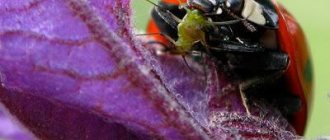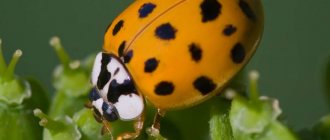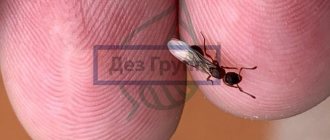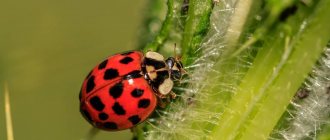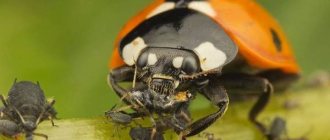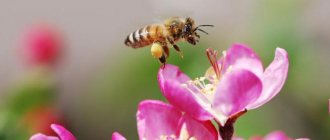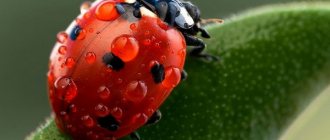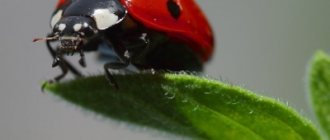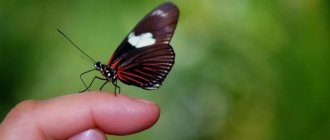What do butterflies eat?
To the question “What do butterflies eat?” one could answer briefly - nectar. They love the nectar produced by various beautiful flowers. Moreover, unlike many insects, butterflies distinguish the color red, which allows them to better navigate in search of food.
And in today’s article we will talk in detail about what butterflies eat at home and how they survive in the wild.
Collection of answers to your questions
And what kind of animals do people keep at home today? Tigers and snakes, crocodiles and monkeys were in fashion. More recently, insects have become popular: ants or stick insects, but the latest hit is butterflies. This is understandable; caring for such animals is not difficult; they do not need to be walked, washed, or vaccinated. However, the life of an insect is short-lived, and if it experiences discomfort, it will die even faster. Therefore, we want to tell all novice entomologists in detail what butterflies eat, how and when, because this is one of the most capricious pets.
Diet in the wild
We all know that every butterfly was originally a caterpillar. So, in the caterpillar stage, it eats a lot, providing itself with food even after it becomes a butterfly. But the protein reserves that the caterpillar deposits in its body are not enough. When they are used up, she has to look for food to maintain vitality.
It would be wrong to say that butterflies eat, since their feeding method is “sucking”. They don't have a mouth as such. Instead, there is a “folding” proboscis with which the insect sucks up food.
It is clear that it will not be possible to suck up anything rough with its proboscis, so the entire diet of a wild butterfly consists mainly of nectar and pollen.
Another favorite delicacy is rotten fruits (pears, apples). They cannot chew, but they can easily suck the juices out of decaying fruits. Moreover, they are rich in sugar.
Also, many may have noticed that they eat bird droppings and manure. The fact is that it contains many microelements that they need for normal existence. Therefore, they do not disdain such a “fragrant” delicacy.
They also love salt. But it is very difficult to get it in the wild. Therefore, many insects get it from human sweat in the summer. You can often see butterflies landing on sweaty people in parks. They do not cause any harm to humans, but simply suck sodium out of sweat.
What is the life cycle of butterflies?
The life cycle of butterflies or, as scientists call it, the full cycle of transformations of a butterfly goes through four stages. These stages are: larva (egg) - caterpillar - pupa (intermediate stage) - imago (adult).
- Mostly butterflies produce 1 generation per year. After the butterfly has laid its eggs, a caterpillar is formed from the larva. The caterpillar can remain in the egg state for up to two weeks.
- After the caterpillar gnaws through the shell of the egg, it exists for an entire period in the form of an insect or in the so-called penultimate molt stage in the life cycle of a butterfly. The caterpillar is a body up to 14 cm long, consisting of a head and several segments (thoracic and abdominal sections) with bristles. They come in completely different shades of color. Caterpillars feed on green parts of plants, as well as wood, fruits of conifers and flowering plants. Some may be predators, while others do not need food at all. This stage can last from a couple of weeks to several years. For the first time in Russian culture, the name “caterpillar” is found in the Laurentian Chronicle, dating back to 1068 according to the new chronology.
All caterpillars are capable of secreting silk fiber. It is from the threads they secrete that the next stage in the life cycle of butterflies is formed.
- With the help of special threads secreted by the caterpillar, it turns into a pupa. Having pupated, the butterfly exists in this stage without feeding.
- The last stage of a butterfly's life cycle is when the butterfly emerges from its pupa. No matter how long the process of the butterfly emerging from the pupa may be, you cannot help it, because your help can only harm the fragile organism.
How to feed your pet
Especially if you caught the butterfly in the wild and did not raise it in your terrarium, then you may have problems feeding the insect. It is very difficult for him to explain that there is food on the plate, so sometimes you have to help:
- If the butterfly is excited, wait until it calms down and folds its wings. Now we carefully take them and bring it to the container with nectar. If she is hungry, she will immediately begin to suck the liquid. If not, then wait and repeat the above procedure.
- Problems can arise when she is scared. In this case, the insect will not eat even if it is hungry. Therefore, we need to help her. Bring the insect to the container with nectar and a toothpick, carefully, try to unfold its proboscis and dip it into the nectar. It should start sucking on it immediately.
- Some species have taste buds on their paws. If your insect is one of these species, you can lightly dip its paws in nectar so that it understands that the food is edible.
Ethics question
Sometimes these insects start on their own, without invitation: they simply fly into an open window. If you release a butterfly, it will spend its short life in the wild. But it is likely that in 5 minutes a bird will eat it. According to experts, by leaving the butterfly at home and providing it with decent care, a person can extend the life of this insect.
In addition, today many people breed tropical butterflies for commercial purposes, selling them for festive events. However, the process is expensive and quite labor-intensive.
Therefore, there is nothing wrong or strange in bringing an insect that has flown into the house from the street or sheltering it and creating suitable conditions for its existence.
We'll look at how to care for temperate butterflies, such as the extremely common butterfly, peacock's eye, burdock, mourning and admiral's butterflies.
Content nuances
We’ve figured out what butterflies eat, now let’s talk about how to keep this exotic insect at home.
First, she needs a home. It should not fly freely around the apartment, so you will have to equip or purchase a special insectarium.
Secondly, it is necessary to maintain a suitable microclimate. They love warmth and at any sign of cold they immediately hibernate. The optimal temperature for their existence is 23-28 degrees Celsius.
Thirdly, the level of humidity is no less important. In dry air the butterfly will die very quickly. To increase humidity, spray the apartment or insectarium with water from a spray bottle. Don't be afraid if droplets get on an insect. It's even useful. This procedure should be carried out 1-2 times a day.
Fourthly, they pay special attention to their sleeping place. If you don’t have an insectarium and they just live in an apartment, then most likely the insects will spend the night on curtains or on indoor plants. If pets live in an insectarium, then you will need to build a resting place for them.
Twigs are perfect. They need to be laid out so that the butterfly can sit down comfortably (they sleep while sitting).
Flew into the house
There is a belief that if a butterfly flies into a house and lands on a person’s hand or shoulder, and it flaps its beautiful wings, then it foretells good news. They are associated with an upcoming marriage, an addition to the family, and even an easy birth.
If a butterfly in a house flies and lands on a person’s hand or shoulder, then it portends good news
A butterfly admiral usually flies to unmarried girls. Here you must definitely take a look at her gorgeous wings. A color that is too bright and variegated will indicate a jealous future spouse. The same sign applies to young people. The jealousy of their spouse will simply torment them. Although many do not believe in these folk superstitions and create happy married couples.
You need to judge your future based on the behavior of the flying insect:
- If a dead butterfly was found in the apartment, then this is not a very good omen. Night moths are popularly called darlings - a messenger from the other world. You can’t kill them, it’s better to release them into the wild so as not to attract trouble or illness into your life.
- If a butterfly appears at home in winter, the sign suggests that you need to prepare dishes and wait for guests or good friends to come to the table. Time will pass in spiritual company unnoticed and will lift your spirits.
- When a large black butterfly suddenly appears in your apartment, you need to beware of your immediate surroundings. White is a harbinger of good news. When she sits on a person’s head, run to get your suitcases and go on a pleasant and exciting journey.
- If a charming insect flies into your apartment in the spring, you can make a wish. After pronouncing words over the calf, you can expect its fulfillment in the near future. The main thing is not to damage the wings of the butterfly, otherwise it will not fulfill it. To enhance the effect of execution, you can additionally read conspiracies.
What happens in winter?
Most species simply hibernate. They find a secluded corner (often under the roofs of houses, in barns) and sleep until spring. In the spring they wake up and continue their life cycle. Some species die, postponing offspring for the future. There are species that fly to warmer regions, like birds.
Caring for these insects is not difficult. In fact, they are not whimsical when it comes to food. It is enough to build or purchase an insectarium, periodically spray it with water from a spray bottle and prepare nectar once a day.
Source
Other subtleties of keeping flying insects
Pets need their own home. They should not constantly fly around the apartment; you will have to arrange a house for them. Buy or make a special insectarium yourself. It will be easier to create a suitable microclimate in it.
- For a comfortable existence of animals, it is necessary that at home, in the room where they live, it is warm. The optimal temperature is 23-28 degrees.
- Humidity level is also important. Butterflies do not live long in dry air. Therefore, spray the room and insectarium with water. It is advisable that a few drops fall on each individual. The procedure must be done 1-2 times a day using a regular spray bottle.
- Your charges need somewhere to sleep. When free, they will most likely hang out on curtains and plants in the apartment. If you want them to sleep in your house, make a place for them there. To do this, place twigs in the insectarium so that you can sit on them and lower wet cotton wool to the bottom. It is better to put the house in a cool place in the evening, and in a warmer place in the morning.
Children are indescribably delighted when such beautiful and unusual animals appear in the house. Caring for them is not so difficult, you just need to follow some rules. Therefore, if your child wants to have a pet, this is a good option. We explained in this article what butterflies eat and how to breed them at home, so now you can easily deal with them.
Video about keeping butterflies at home
In this video, Anton Lobanov will show you the conditions in which to keep butterflies at home and show you the process of feeding them:
Source
How to feed and care for butterflies
Butterflies feed on sugar syrup, juicy citrus fruits or crushed bananas. You need to feed the butterfly once a day. The easiest way to feed a butterfly is to prepare sugar syrup for it or buy special food for butterflies in our store.
- Mix one or two teaspoons in a glass of warm water and pour a small amount onto any surface or saucer.
- Take the butterfly as shown in the picture and place its front paws on a treat.
- If the butterfly does not straighten its proboscis, take a toothpick and straighten it yourself so that it touches the food. If the proboscis remains in the food, the butterfly is eating; if the proboscis is curled up, then the butterfly is not hungry and can be fed later.
How to feed an insect?
This question worries many beginners. After all, you can’t explain to a butterfly that it’s time for dinner, here’s her plate. Professionals give the following advice:
- Wait until the butterfly calms down and folds its wings. Take her by them (very carefully) and bring her to the food;
- A hungry animal quickly unfolds its proboscis and begins to eat. If it breaks out, it means it is not hungry;
- When you can’t feed an insect for a long time, help it. This happens sometimes when it is scared. Take a toothpick, try to carefully release the proboscis and dip it in the nectar;
- Or lower it with its paws onto a plate; in some specimens, the taste buds are located precisely on the legs.
General information
- You can only pick up the butterfly by the body at the base of the wings;
- The butterfly is active at temperatures above 20 degrees
- You can release a butterfly to fly around the apartment. Butterflies love to sit on curtains;
- Butterflies, like many insects, fly towards the light. If a butterfly flies into the chandelier, simply turn off the light and take out the butterfly;
- It is more convenient to feed the butterfly in a cooled room;
- Butterflies live from a couple of days to a couple of weeks.
On our farm you can always buy live butterflies, fireworks from live butterflies, or buy a butterfly farm and raise butterflies yourself
Source
sits on a person
It is a good sign that if a butterfly flies around the apartment, it means that there will be profit in the house and good luck in business. When she sits on a person, there is a meeting with old comrades.
When a butterfly lands on a person, there is a meeting with old comrades
Another sign predicts if a butterfly lands on a person’s shoulder. On the right side - you can expect long-awaited guests or out-of-town friends, on the left side - a person will encounter unpleasant people.
By reading literature, you can learn a lot; the combination of “butterfly and superstition” has different meanings among peoples.
A beauty that has flown into an apartment can flutter for a long time and then land on its left shoulder. Usually this side indicates negativity in a person's life. By landing, the insect signals that you need to pay attention to a secret enemy with whom no one has yet entered into a secret confrontation.
If a butterfly flew into the window and landed on your hand, the feelings between lovers are real and sincere, they reciprocate each other. When several cute insects land on your hand at once, a person will experience incredible luck, success in business and financial profit.
The winged beauty sat down to rest on the man’s leg - he will have to walk for a long time to resolve difficult issues. But if a butterfly appears in your house in winter, you can expect a pleasant trip, and in the near future. So hurry up. The duration of the journey and the journey depends on the length of the insect’s wings.
The winged beauty sat down to rest on a man’s leg - he will have to walk for a long time to solve difficult issues
When an insect arrives and flickers in front of your face or its wings touch your cheeks or forehead, it foreshadows imminent happy events. We noticed on the beach that an insect was sitting on its bare stomach; here folk superstitions talk about marriage proposals. The pregnant woman can expect an easy labor without complications.
People even interpret insects by the color of their wings. Depending on the color scheme, there may be different meanings. For example, if the color of the wings is red and their coloring itself is bright and rich, then a lonely woman can meet her soul mate and find family happiness. Brown color predicts strong relationships, and blue or green predicts peace.
Water with sugar for butterflies
What to feed live butterflies, what do different types of butterflies eat?
The lifespan of a butterfly is unpredictable, like any other living creature. But using averaged statistical observations, it is possible to indicate the approximate dates of a particular species of butterfly. Butterflies need to be fed at least once a day, and preferably 2 times - in the morning and evening. At night we put the butterfly in a dark box.
With proper care and feeding, the longest-living and most unpretentious species of all are the Owl butterfly (lives up to a month) and the Morpho butterfly (lives about 3 weeks).
What species are kept in captivity?
Butterflies are the most beautiful representatives of the insect world. There are a huge number of varieties of them. There are giants with a wingspan of up to 30 cm and dwarfs with a length of several millimeters. In winter you can admire them in special greenhouses, but few know that they also take root at home.
Experienced breeders have been keeping winged beauties in apartments for a long time. Of course, experts are trying to get hold of rare tropical specimens, but a young entomologist can start with those that live close to home.
Before you get down to business, read the special literature, which tells you how to arrange a suitable regime for animals, how and what to feed. After all, this is an extremely gentle and capricious creature; if the climate is unsuitable, it will not live long.
Now wait, the pets will soon eat up and the process will begin. But do not forget to occasionally spray the container with water, otherwise the insects will not have enough moisture and they will die. After 2-3 days or a couple of weeks, depending on the type
, the dolls will be reincarnated.
Butterflies offered today for keeping at home can be divided into 3 types:
1) Butterflies that feed on their own. Basically, all American species (Owl or Caligo butterfly, Morpho butterfly, Cyproeta Stelenes butterfly).
These are butterflies of closed spaces, they live in the forest and prefer fermenting fruits. At home, it is enough for them to offer them chopped (or better yet, overripe, as in nature) fruits, and they themselves unfurl their proboscis and begin to drink. In nature, fallen fruits of various fruits, lying on the ground, gradually become soft and fragrant; butterflies fly to such fruits with great desire; it is easier for them to pierce the soft parts of these overripe fermented fruits with their proboscis. Oranges, grapefruits, bananas (overripe!), mangoes, kiwis, and passion fruits are suitable for feeding at home. We feed at least once a day, preferably 2 times (morning and evening).
2) Butterflies are whimsical, they need to make sweet water and unfold their proboscis. These are, for example: Swallowtails, birdwing Troides, Graphium, Sylvia, Demolay. These are butterflies of open spaces - they fly in meadows, forest edges, etc. They prefer flowers and nectar. You can make sweet water based on regular sugar (ideally fructose) or honey (natural). It is better to take boiled water (room temperature). In 1 cup, stir about 2-3 teaspoons of sugar or honey, stir until completely dissolved. Then pour the resulting nectar into a saucer. We carefully take the butterfly at the base of the wings perpendicular to its wings; it is most convenient to do this between the middle and index fingers. Having fixed the butterfly in this way, we bring it to the saucer with nectar and unfold the proboscis with a needle or a regular toothpick. The proboscis is located on the head under its antennae (see photo below). As soon as the tip of its proboscis hits the nectar, the butterfly begins to drink (If the butterfly is hungry). Now you can let go of the wings and not disturb the butterfly until it drinks. We feed at least once a day, preferably 2 times (morning and evening).
Honey “nectar” and rotten fruits
Even children know what these insects feed on in nature: pollen and nectar of flowers. However, the diet of butterflies is not limited to this; for example, many species happily drink the juices of rotten fruits. By the way, representatives of the sailfish family, as well as the usual nymphalids, need sodium vitally. Peacock's eye, admiral's eye or burdock can often be seen in summer sitting on moist clay soils or whitewashed trunks of fruit trees. Butterflies also love to land on sweaty people. These are the ways to get your own salt.
Therefore, there is nothing complicated about how to care for a butterfly and what to feed it. To prepare nectar at home you need 1/5 tsp. Dilute honey in 2 tsp. water. The mixture is prepared in a rosette, saucer or small jar lid. The insect is carefully taken across the abdomen and placed on the edge of the food container. A hungry butterfly will immediately straighten its proboscis and begin to suck in “nectar.” The meal can last from 2 to 15 minutes.
They also prepare food for the butterfly from overripe fruits. A piece of apple, pear, banana, mango, melon or watermelon pulp is kneaded in water to a liquid consistency. It is recommended to offer your pet food 2 times a day.
The task becomes more complicated, but becomes even more interesting if you want to see with your own eyes how a luxurious butterfly will be born from a not particularly attractive caterpillar.
What does a ladybug look like?
Some representatives have red elytra with black dots; in nature, orange, black with red dots, and completely brown or black are also found. The body structure includes the head, thorax and abdomen. There are a pair of antennae, a pair of compound eyes on the head, and six segmented legs that attach to the thorax. Under the thick, hard elytra there is an additional pair of thin wings. Different species have different feeding habits. What do ladybugs eat? In nature there are predatory and herbivorous species. Vegetarians in the ladybird family feed on mushrooms and leaves. Some eat insects that eat plants (aphids, midges).
Diet of domestic butterflies
They are often kept as pets. Moreover, keeping butterflies is not such a difficult task if you raise an omnivorous insect. Certain species of butterflies are very picky eaters and feed on certain nectar from certain plants. These pets are not suitable for home keeping.
In summer, insects can be fed with flower leaves, pollen, etc. But in winter they will have to prepare nectar. To do this you will need the following ingredients:
- 2 tsp. water;
- 1/5 tsp. honey
Take a container and pour water into it. Add honey and stir everything thoroughly. We feed this solution to insects.
You can also make pastes from fruits such as bananas, apples, oranges, pears, etc.
